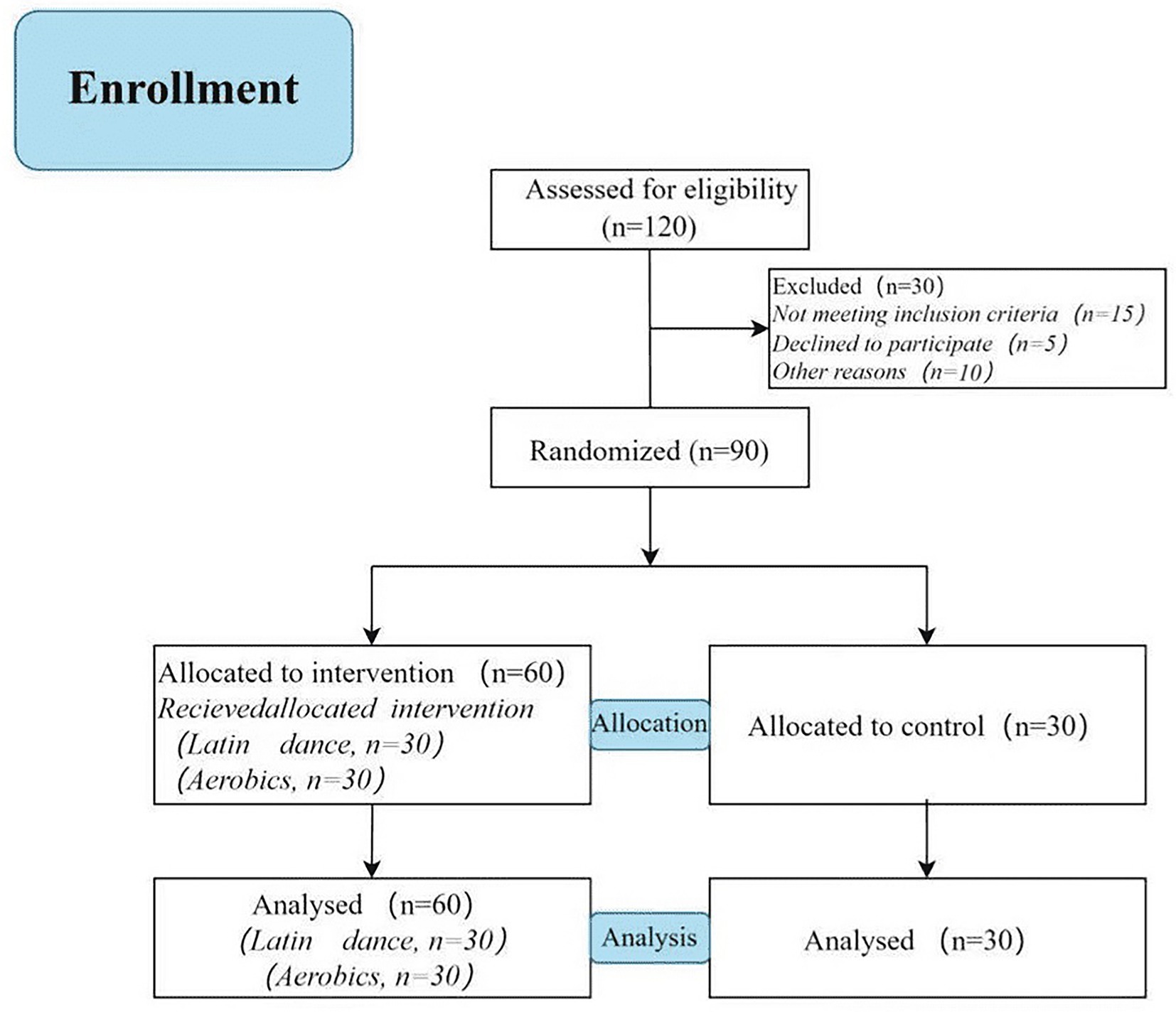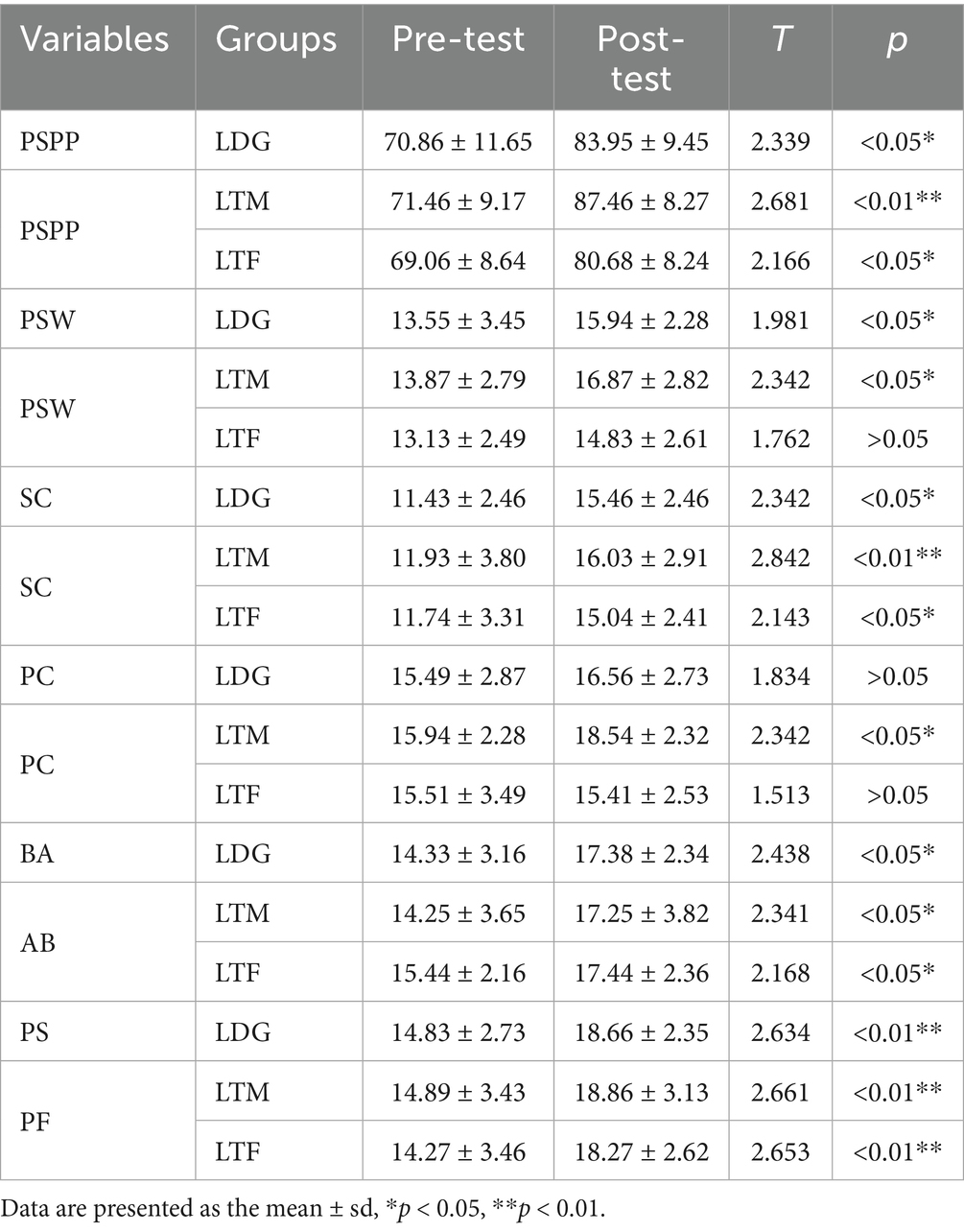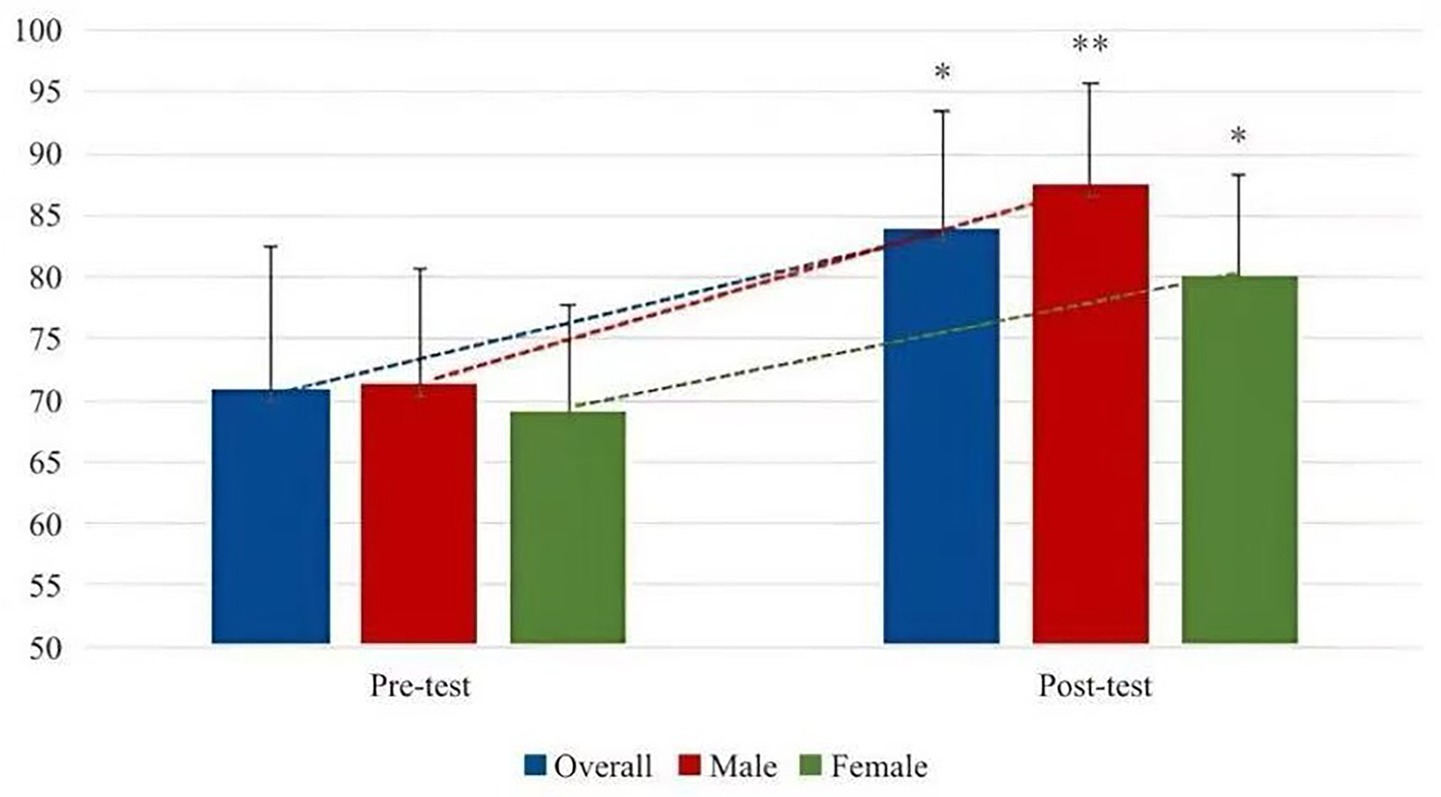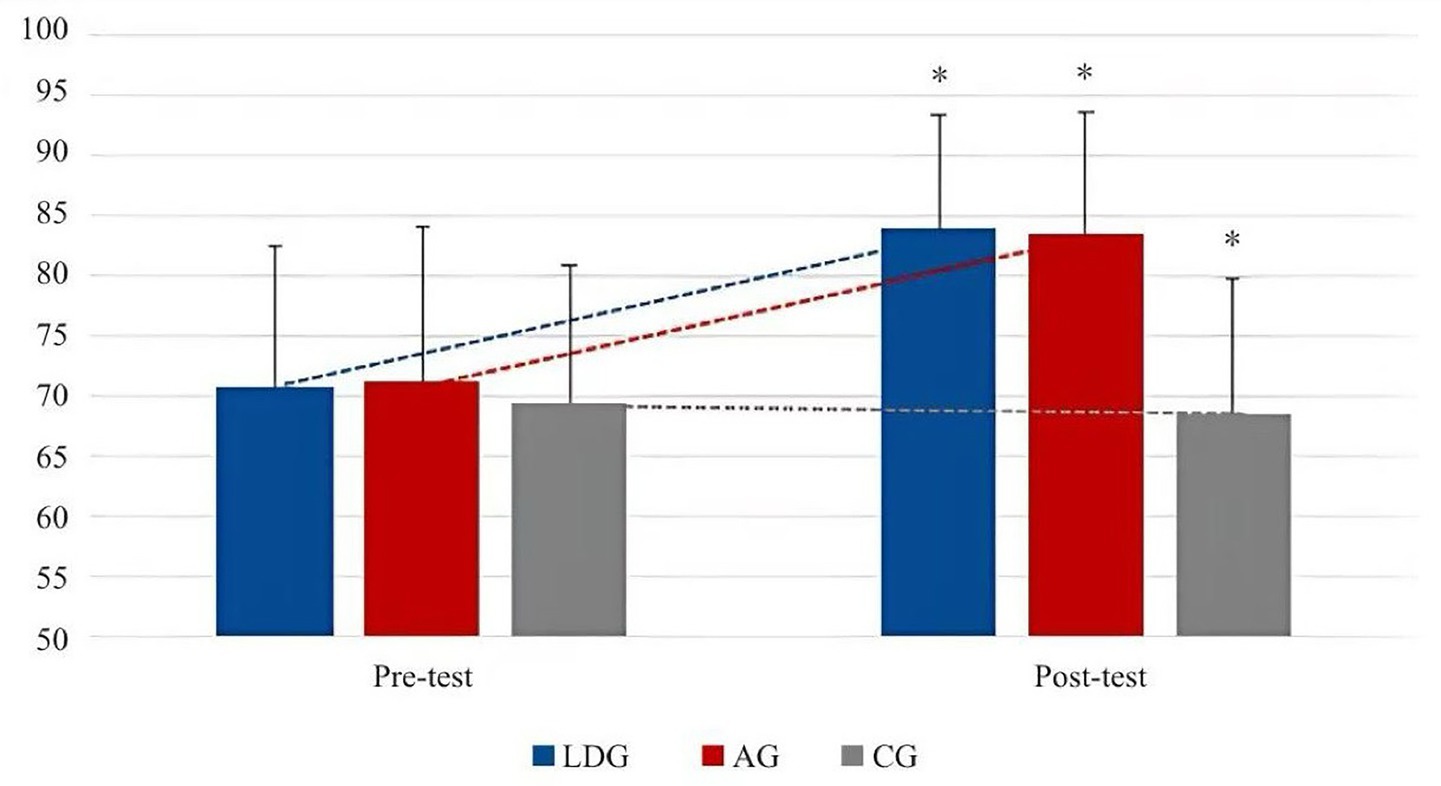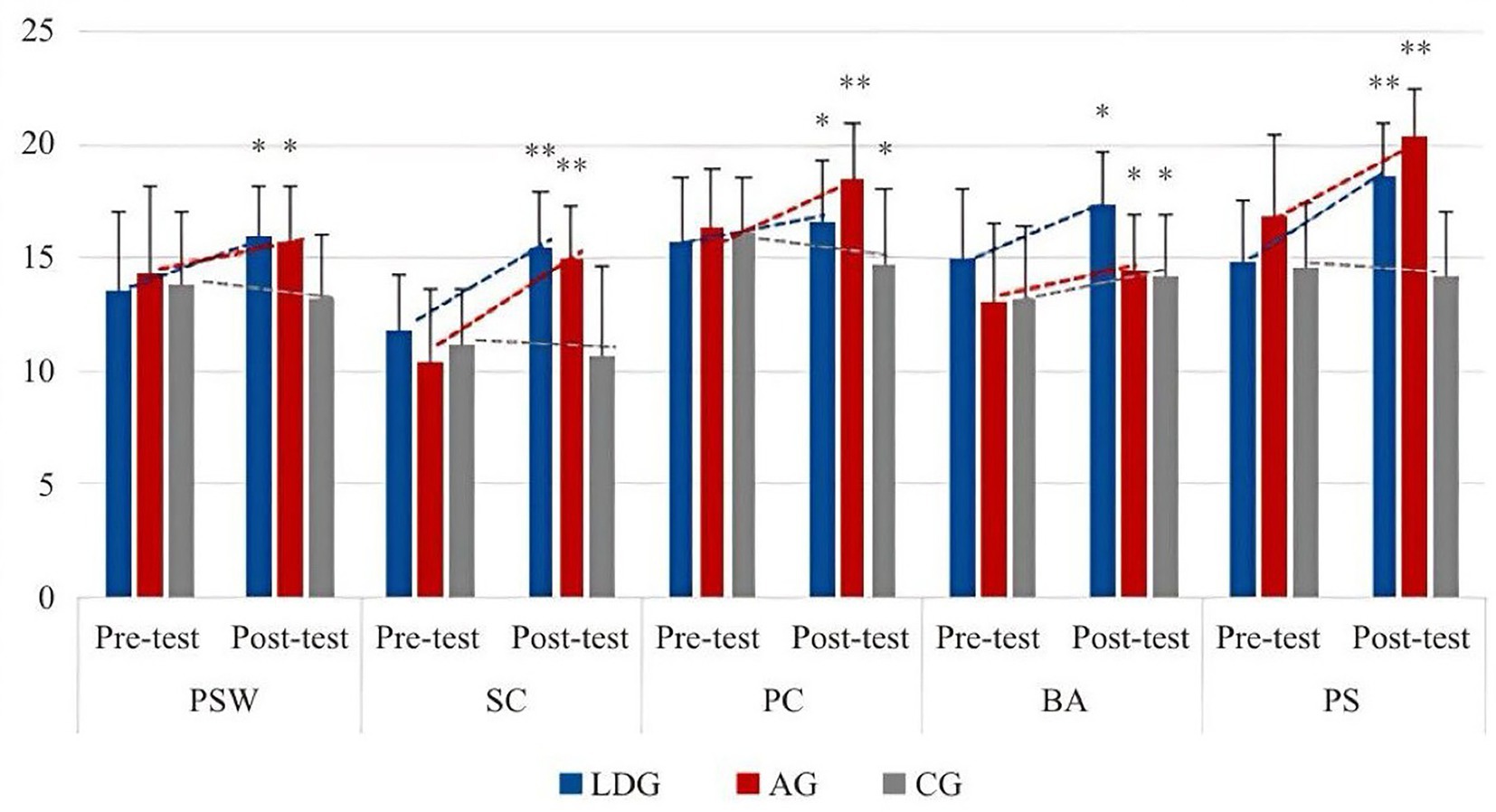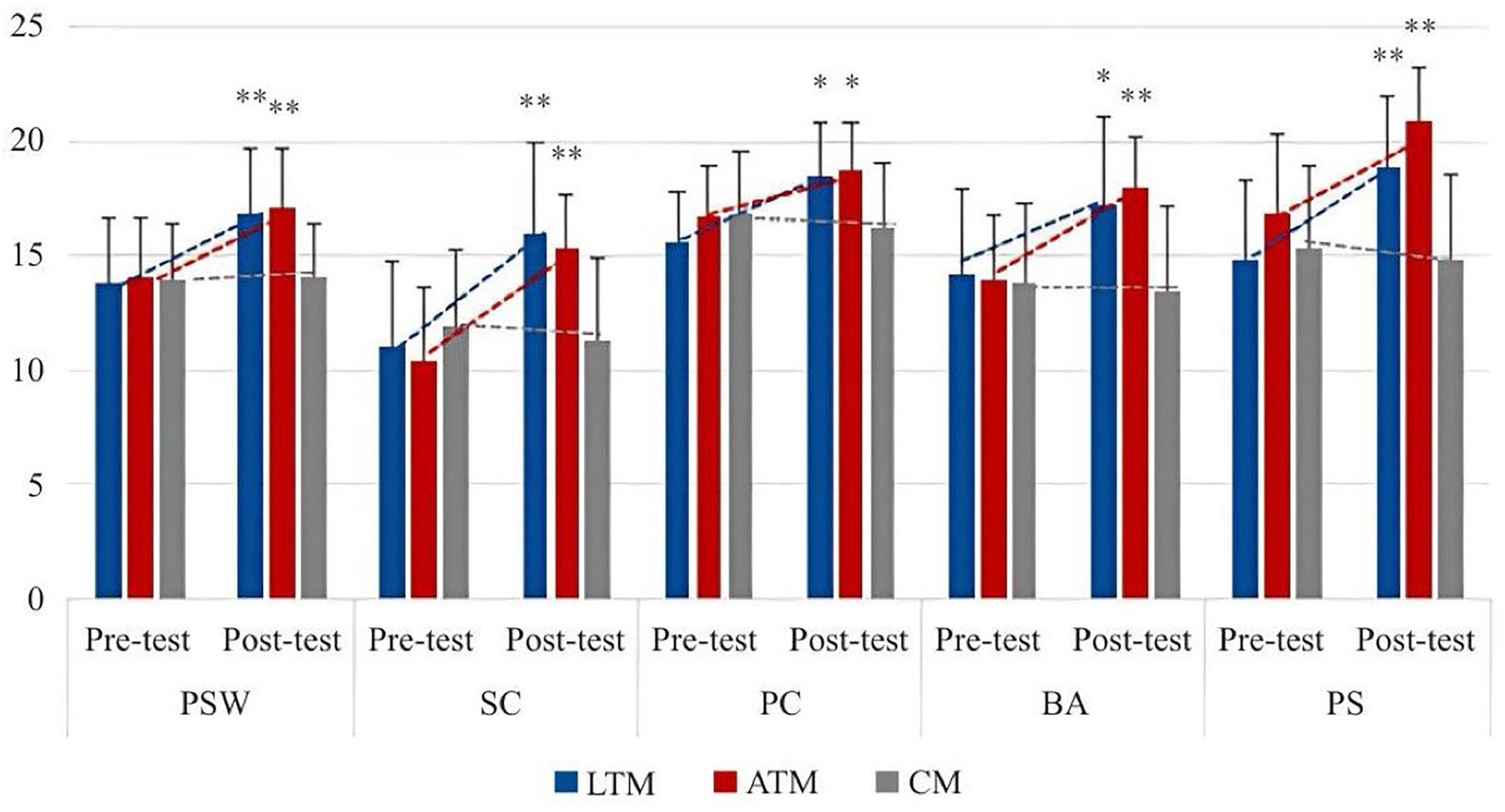- 1School of Physical Education, Jinan University, Guangzhou, China
- 2Guangdong Provincial Key Laboratory of Speed Capability Research, Su Bingtian Center for Speed Research and Training, Guangzhou, China
- 3College of Physical Education, Anhui Normal University, Wuhu, China
Background: Body esteem is pivotal to college students’ psychological well-being. Evidence suggests Latin dance and aerobics can enhance body image, but comparative, gender-specific effects remain underexplored.
Methods: In a 12-week randomized controlled trial, students (N = 90; 45 men, 45 women) were assigned to Latin dance group (LDG), aerobics group (AG), or control group (CG). Body esteem was assessed pre- and post-intervention using PSPP subscales: sport competence (SC), physical condition (PC), body attractiveness (BA), physical strength (PS), and general physical self-worth (PSW). Statistical analyses included independent sample t-tests, paired sample t-tests, and ANOVA.
Results: Both LDG and AG improved overall body esteem versus CG (p < 0.05). Compared with CG, LDG produced greater gains in BA and SC (p < 0.05), with significant benefits among female participant (BA, SC: p < 0.05). AG produced larger improvements in PC and PS versus CT (p < 0.05), with significant gains among male participant (PS: p < 0.01; PC: p < 0.05). No between-group differences were observed for PSW (LDG vs. AG, ns).
Conclusion: This study indicates that both Latin dance and aerobics effectively enhance body esteem among college students but through distinct mechanisms. Latin dance particularly improves emotional and social dimensions of body esteem, offering pronounced benefits for female participant, while aerobics primarily enhances physical fitness aspects, more effectively benefiting male participant. These findings underscore the importance of providing diverse exercise modalities in university wellness programs to cater to varied gender-specific psychological and physical health needs.
Clinical trial registration: ChiCTR25063201.
1 Introduction
Body esteem, which refers to the self-evaluation of one’s appearance and body shape, is crucial to an individual’s psychological health and overall well-being, especially for college students (Merino et al., 2024; Pop and Ciomag, 2024; Wang et al., 2025). During this transitional period in life, college students are often subject to social pressure and unrealistic aesthetic standards (Biderman et al., 2025; Merino et al., 2024), which may lead them to develop a negative body image and self-esteem (Bahri, 2024). Existing studies have demonstrated that physical activity is an effective intervention measure to enhance body esteem and has shown positive effects (Hale et al., 2021; Herbert, 2022; Morales-Sanchez et al., 2021; Singh et al., 2023). Among them, Latin dance and aerobic exercise are popular due to their engaging nature and potential health benefits (Hu et al., 2024; Li et al., 2023; Liu and Zhao, 2022; Liu and Zhao, 2022; Shu et al., 2023). However, there is a gap in comparative research on the specific effects of Latin dance and aerobic exercise on college students’ body esteem.
1.1 The impact of Latin dance on body esteem
Latin dance programs are often performed in pairs or groups and are social in nature, creating a sense of community and belonging (Harman, 2018). They are forms of movement that incorporate movement, music, and cultural expression, including rumba, cha-cha, samba, paso doble, and jive. These dances are often characterized by dynamic, fluid movements that emphasize rhythm, coordination, and self-expression (Li et al., 2023; Li et al., 2022). This social element can also positively promote interaction, boost confidence and improve body esteem (Sanchez, 2020). Dance, especially Latin dance, has been shown to have a positive impact on mental health and body image (Koch et al., 2014; Liu et al., 2023; Monteiro et al., 2018; Moratelli et al., 2023). Latin dance emphasizes body control (Li et al., 2023), posture (Li et al., 2022), and grace (Hu et al., 2024), which may help individuals develop a positive relationship with their bodies. Additionally, the social interactions inherent in Latin dance classes can reduce feelings of isolation and increase feelings of acceptance and self-worth (Ingram, 2013; Salo, 2019). People who participate in dance have higher levels of body satisfaction and self-esteem than those who engage in other forms of exercise. Additionally, Latin dance promotes creativity (Li et al., 2023) and self-expression (Ege and Omuris, 2024), which are important aspects of mental health. Moving freely, expressing oneself through dance (Shapiro, 2008), and embracing one’s cultural heritage may create a sense of empowerment that can improve body esteem. Research has also highlighted the benefits of Latin dance in fostering a positive body image, as it encourages people to embrace their bodies’ abilities rather than focusing solely on their appearance. This shift in focus may help improve body esteem by promoting a more holistic view of the body.
1.2 The impact of aerobics on body esteem
Aerobics is a form of high-intensity exercise with structured movements that focuses on cardiovascular fitness, endurance, strength and flexibility (Wilmore, 2003). Aerobics helps improve physical fitness (Chekhovskaya, 2023), improved mood (Liu et al., 2024), and reduced anxiety (Aishwarya and Kumar, 2024). Aerobics has also been associated with improved self-esteem and improved body image (Kuang, 2024), as individuals experience tangible improvements in their fitness levels and appearance. Aerobics can help control weight, muscle tone, and overall physical health (Riaz et al., 2024), which can have a positive impact on how individuals view their bodies. Additionally, the structured movement nature of aerobics involves setting goals, tracking progress, and achieving milestones, which can create a sense of accomplishment and boost self-esteem (Kuang, 2024). One study found that aerobics can significantly reduce body dissatisfaction, especially in those who previously had low body esteem (Henry et al., 2006).
However, compared to dance, aerobics may lack the same level of emotional and social engagement. While aerobics can indeed improve body image through physical changes, the psychological benefits related to self-expression, social connection, and cultural identity may not be as prominent. For many participants, the focus of aerobics may be primarily on fitness goals rather than the enjoyment of exercise or self-expression. So while aerobics does improve body esteem, the magnitude of this improvement may not be the same as the benefits of more expressive forms of exercise, such as Latin dance.
1.3 Gender differences in body esteem and physical activity
Gender differences in body esteem are well established, with female participant often reporting lower body esteem than male participant (Hagger and Stevenson, 2010; Kling et al., 1999), especially in cultures where appearance is highly valued. In contrast, male participant may be more concerned with muscularity and physical strength, but these concerns are often less pronounced than the body image pressures female participant face. The effects of physical activity on body esteem may differ by gender due to differences in psychological experiences and social expectations (Ómarsson, 2013). Female participant tend to gain greater body esteem through outward-focused activities (dance or aerobics) (Wang et al., 2025), male participant, on the other hand, may focus more on the functional aspects of exercise, such as strength and endurance. Latin dance, with its emphasis on fluidity, posture, body awareness, and partnering, may offer a more holistic way for female participant to improve their body esteem because it fosters self-expression and appreciation of the body, rather than just physical fitness. In contrast, aerobics may be seen as more practical and improve physical condition, but may lack the same level of emotional investment for women, which may result in less noticeable changes in their body esteem. For male participant, aerobics classes often focus on athletic performance goals such as endurance or weight loss, which can resonate with men’s body image issues, especially those related to a lean, toned physique. On the other hand, most men are not very supportive of Latin dance because of cultural perceptions that dance is a more feminine activity, which may limit its impact on the body esteem of male participant participants. However, over time, these perceptions may fade as dance is adopted as a unisex form of fitness.
Therefore, the main purpose of this study was to compare the effects of 12 weeks of Latin dance and aerobics training on body esteem among college students of different genders. Given that Latin dance and aerobics are both effective forms of exercise, understanding how they affect body esteem differently in male participant and female participant can provide recommendations for promoting psychological and emotional health in college students. This randomized controlled trial will provide empirical evidence on the psychological benefits of these two forms of exercise, with a particular focus on their effects on body esteem in different gender groups. Our hypotheses are as follows:
H1: Both Latin dance and aerobics will lead to significant improvements in body esteem compared to baseline measurements.
H2: The improvement in body esteem in the Latin dance group will be greater than that in the aerobics group.
H3: There are gender differences in the improvement in body esteem, with female participant achieving greater improvements through Latin dance and male participant achieving greater improvements through aerobics.
2 Materials and methods
2.1 Participants
This study was conducted in the Latin dance and aerobics club of Yichun University, China. Prior to recruiting participants, an a priori efficacy analysis was conducted using G*Power 3.1 to determine the minimum sample size required for this study. The following parameters were set: effect size f = 0.23 (between small and medium), significance level α = 0.05, expected efficacy 1 - β = 0.85, repeated measures correlation coefficient r = 0.50, and non-spherical correction factor ε = 1. Calculations indicated that a total sample size of at least N = 84 would be needed. We selected 90 first-year university students who voluntarily participated in the club, including 45 male participants and 45 female participants (Aged between 18 and 21). The 45 male participant students were randomly divided into three groups: 15 Latin dance training for male participants (LTM), 15 aerobics training for male participants (ATM), and 15 control groups (Control for male participants, CM); the 45 female participants were randomly divided into three groups: 15 Latin dance training for female participants (LTF), 15 aerobics training for female participants (ATF), and 15 control groups (Control for female participants, CF). Inclusion criteria: no serious cardiovascular, respiratory, musculoskeletal diseases or other chronic diseases that may affect participation in sports training; after basic physical examinations or health questionnaires, it was confirmed that the basic physical conditions for participating in sports were met. Exclusion criteria: patients with severe mental disorders (such as major depression, anxiety, etc.); patients who are currently receiving relevant medications; patients with eating disorders and other behavioral problems that affect body image and self-esteem. Participants in each group underwent Functional Movement Screen (FMS) tests (Cook et al., 2014) before training, and no differences were found between the groups (Table 1). Figure 1 shows the progress of enrollment. All participants signed informed consent forms approved by the Hunan Normal University Ethics Committee (Approval ID: 2024646).
2.2 Intervention
The experiment lasted for 12 weeks. The courses of exercise intervention were Latin dance and aerobics. Participants attended three classes per week, each class lasted 2 hours, with a 10-min break in between. The content of Latin dance training courses included basic steps, single and double combination routines, and dance music understanding exercises. The content of aerobics courses included basic steps, complete movement routines, and creation exercises. Each course was divided into three stages: basic (weeks 1–2), consolidation (weeks 3–7), and improvement (weeks 8–12). During the intervention, as the teaching content progressed, the intensity of the teaching class gradually increased. Since the teaching time was the same, the intensity of Latin dance and aerobics teaching was appropriately controlled to ensure that the difference in exercise load intensity in the two teaching classes was not large. During the training period, as the difficulty of the teaching content increased, the load intensity gradually increased. The specific intensity control is shown in Tables 2, 3. In order to evaluate the teaching effect and quality of the teachers, the participants presented their learning results after the entire training.
2.3 Measurements
The Physical Self-Perception Profile (PSPP), developed by Kenneth R. Fox in 1990, is a multidimensional psychometric instrument designed to measure an individual’s self-perceptions related to their physical characteristics and abilities (Fox, 1990). PSPP has been widely used in many studies (dos Bucco Santos et al., n.d.; Chair et al., 2024; Jati et al., 2024; Nicolosi et al., 2024). It comprises five subscales—Sport Competence (SC), Physical Condition (PC), Body Attractiveness (BA), Physical Strength (PS), and General Physical Self-Worth (PSW)—each with six forced-choice items (30 items total). For each item, respondents choose between two contrasting statements and then indicate whether the choice is “really true” or “sort of true”; items are scored 1–4, yielding subscale totals of 6–24, with higher scores reflecting more positive perceptions. Subscales may be analyzed separately or jointly to assess domain-specific and overall physical self-esteem and to evaluate the effects of physical activity or interventions on physical self-concept.
2.4 Statistical methods
All data were statistically analyzed using IBM SPSS Statistics 30.0.0 software. To evaluate intra-group changes and inter-group comparisons, independent sample t tests, paired sample t tests, and one-way analysis of variance (ANOVA) were used. Data were described as (mean ± standard deviation) and statistically significant accepted p < 0.05. For the differences between groups after ANOVA, post hoc tests were performed using the Bonferroni method and the corrected p-value was reported. The following are the statistical analysis methods used for each hypothesis:
H1: Use a paired t test to evaluate changes in body self-esteem before and after Latin dance and aerobic exercise.
H2: The differences in the Latin dance and aerobic exercise groups in terms of body attractiveness (BA) and motor ability (SC) were compared using independent sample t test or one-way analysis of variance (ANOVA).
H3: Use independent sample t test or gender-based variance analysis to compare the effects of different genders in two forms of exercise.
3 Results
3.1 Changes in body esteem before and after Latin dance training
After 12 weeks of Latin dance training, the changes in various indicators of body esteem are shown in Table 4.
From Table 4, Latin dance teaching significantly improves students’ body self-esteem, and male participants are ahead of female participants. In the five small dimensions, except for the evaluation of physical condition, the other dimensions are significantly improved. In the longitudinal comparison of PC, male participants have improved significantly, while female participants have not significantly changed and have slightly decreased. In the other four dimensions, male participants’ physical self-esteem and SC have improved faster than female participants, and the difference in female participants’ physical self-esteem is not significant. In terms of BA and PS, the improvement of male participants and female participants is basically the same, and the improvement of PS is very obvious. The specific improvement trend is shown in Figures 2, 3.
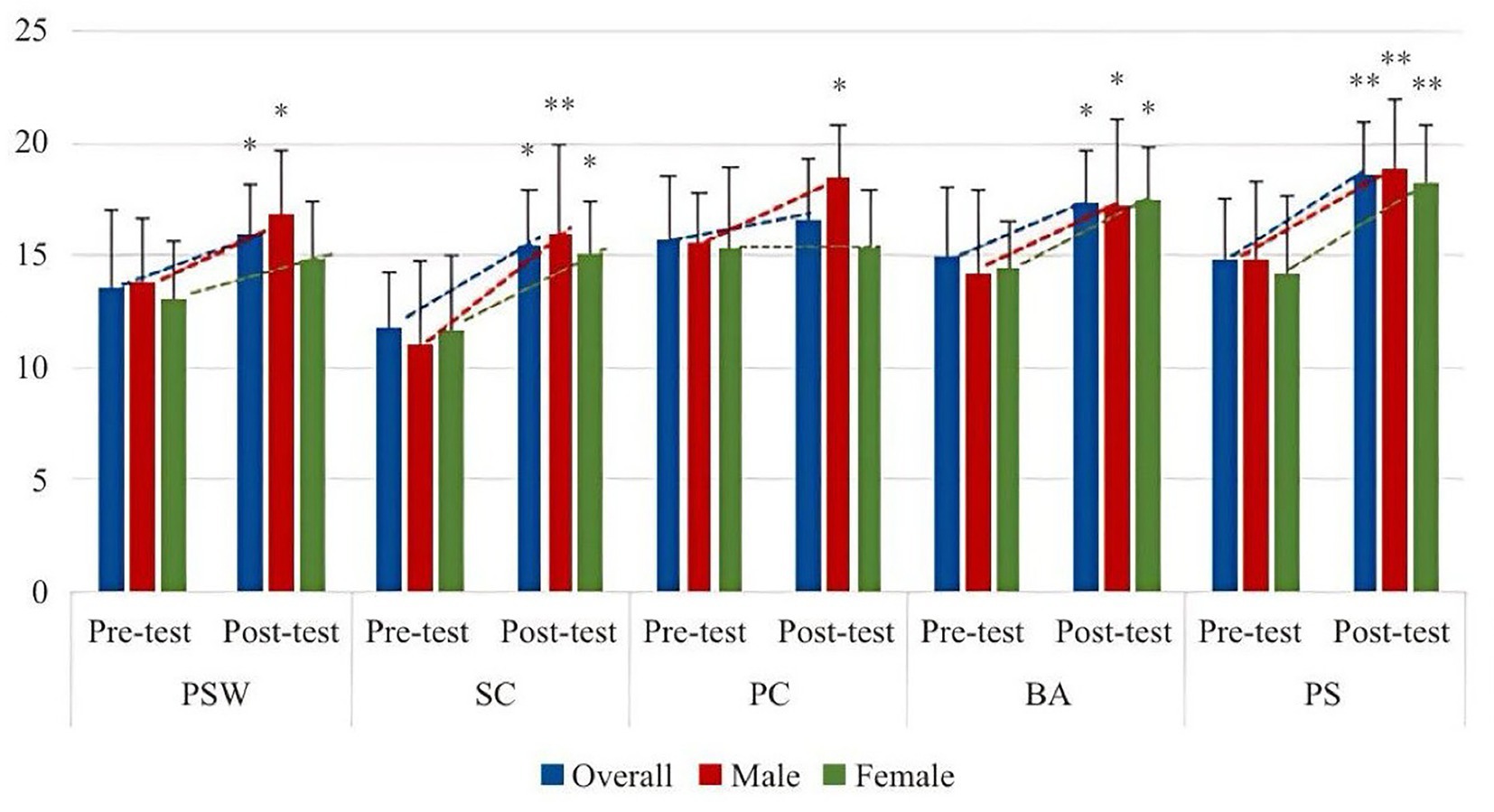
Figure 3. The changing trend of the effects of Latin dance training on various dimensions of body esteem.
3.2 Difference analysis of body esteem after the experiment
3.2.1 Comparison of specific scores of body esteem levels after the experiment
From Table 5, there was no significant difference between LDG and AG (original p > 0.05), but compared with CG, there was a significant difference (adjusted p < 0.05, corrected by Bonferroni). On each dimension, the difference in PSW was p > 0.05, with no significant difference, but the difference between the two groups and the control group was p < 0.05, and the difference was significant after Bonferroni correction, but the difference between the two groups and the control group is p < 0.05, which is significantly different from the control group; in the evaluation of PC, the difference p value between each two groups is less than 0.05, and the difference is significant. The order of evaluation level from high to low is AG, LDG, CG, in the evaluation of BA, the difference p value between each two groups is less than 0.05, and the difference is significant, and the order from high to low is LDG, AG, CG; in the evaluation of PS level, the difference between AG and CG is p < 0.01, and the difference is very significant. The p values of the other two groups are less than 0.05, and the difference is significant. The order of evaluation level from high to low is AG, LDG, CG. The changing trends of the total score and each dimension of body esteem in each group are shown in Figures 4, 5.
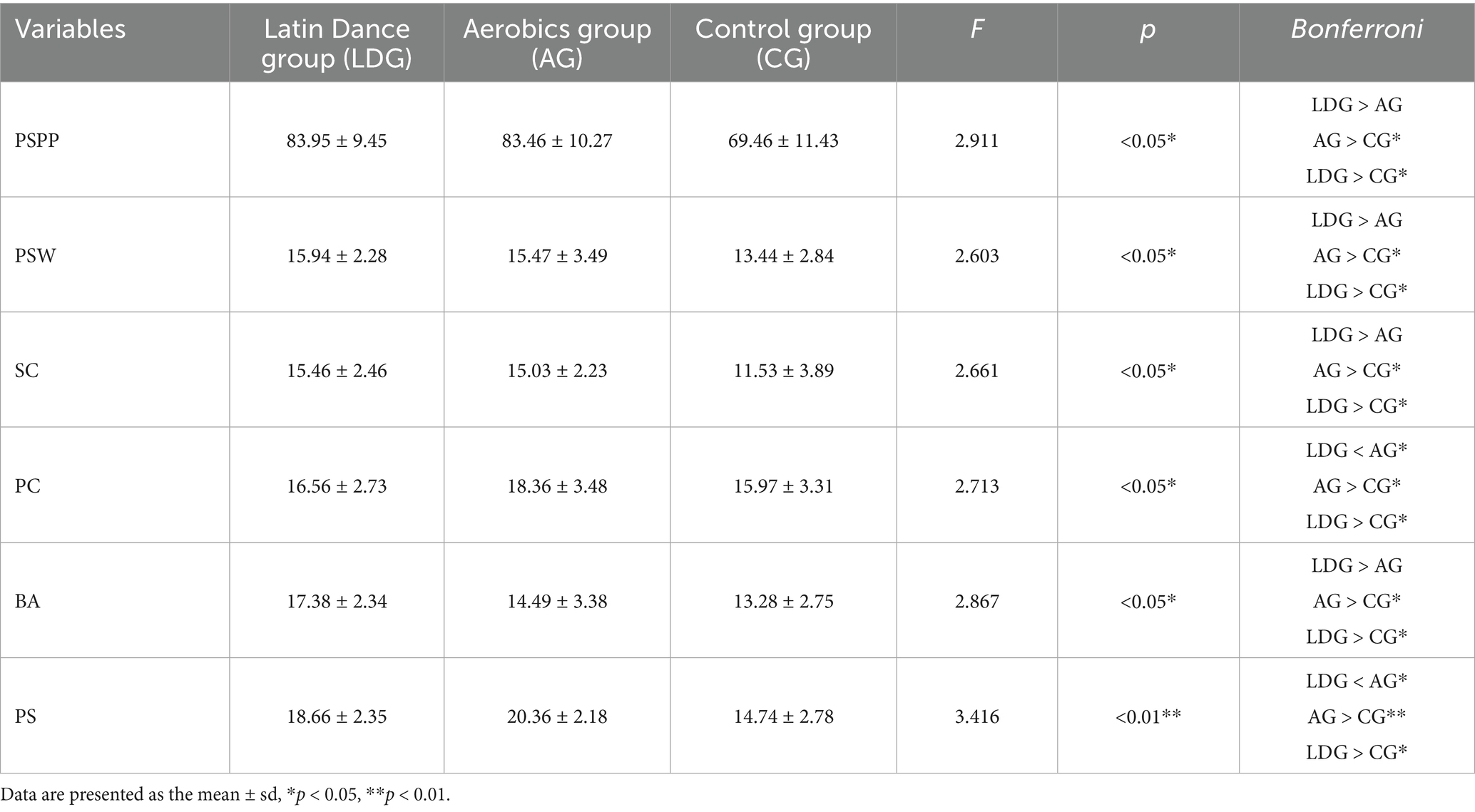
Table 5. Comparative analysis of body self-esteem levels among groups after the experiment (M ± SD).
3.2.2 Comparison of body esteem scores between different genders after the experiment
3.2.2.1 Comparison of body esteem scores of male participant after the experiment
From Table 6, we can see that in the comparison of body self-esteem between LTM and ATM, the p value of the overall self-esteem level is greater than 0.05, which does not reach a statistically significant difference. In the five small dimensions, the p values of PSW, SC, PC, and BA are all greater than 0.05, which does not reach a statistically significant difference. Only PS shows a significant difference. Combined with the level before the experiment, LTM and ATM are ahead of CG in overall body self-esteem.
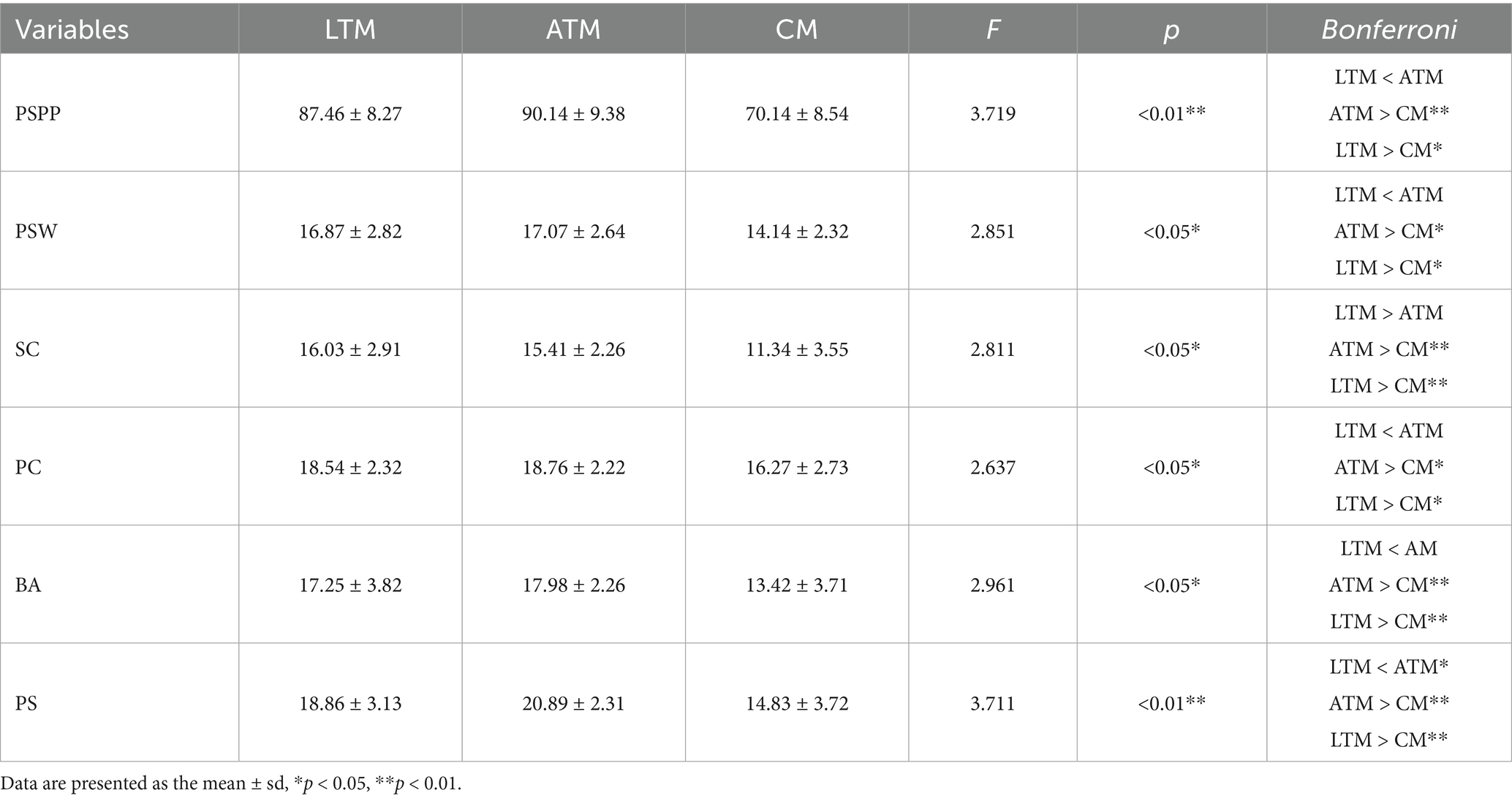
Table 6. Comparative analysis of the differences in body self-esteem among males in each group after the experiment (M ± SD).
In general, the overall level of body esteem of ATM was slightly higher than that of LTM, but there was no significant difference. From a small dimension, Latin dance and aerobics both had a greater ability to improve SC, PC, and PS, and had a smaller improvement on PSW and BA. Latin dance was slightly better than aerobics in improving SC and PC, and aerobics was slightly better than sports dance in improving BA and PS. The changing trend is shown in Figures 6, 7.
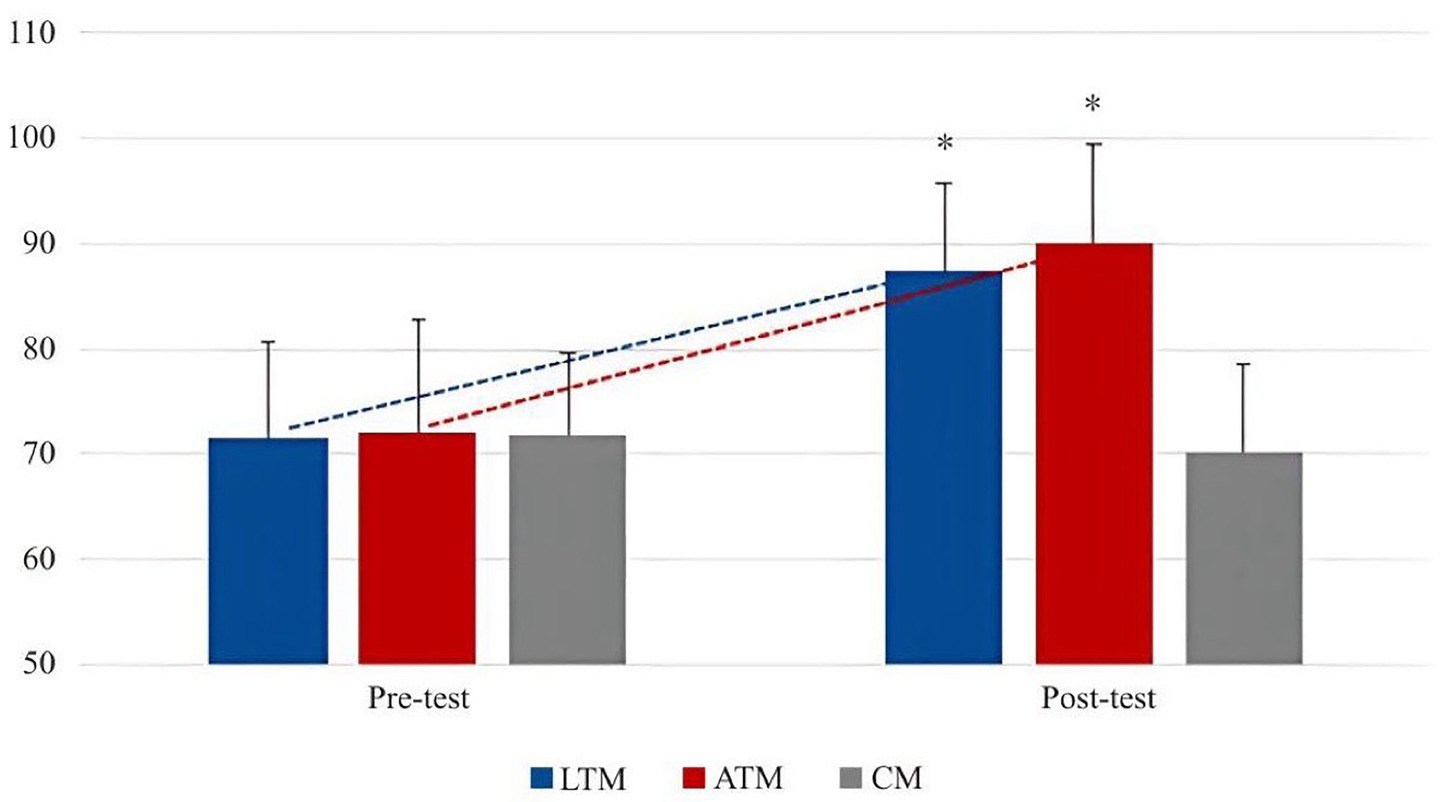
Figure 6. The trend of the total scores of body esteem in each group of males between pre- and post-test.
3.2.2.2 Comparison of body esteem scores of female participant after the experiment
From Table 7, after the experiment, in the evaluation of female participant’s body self-esteem level, LTF was slightly higher than ATF, which did not form a statistically significant difference (p > 0.05), but the difference was significant compared with CF (p < 0.05). In the comparison of small dimensions, in the evaluation of PSW, there was no statistical difference between ATF and LTF and CF (p > 0.05), but there was a significant difference between LTF and CF (p < 0.05). In the SC evaluation level, there was no significant difference between the LTF and ATF groups (p > 0.05), but the difference between the two groups and CF was p < 0.05, which was significantly better than the control group. In the PC evaluation level, ATF was significantly different from the other two groups (p < 0.05). In the BA, the difference in the evaluation level between each two groups was p < 0.05, and the difference was significant. The order from high to low was LTF, CF, and ATF. In the PS evaluation level, the average levels of ATF and LTF were high, among which the difference between ATF and CF was very significant (p < 0.01), the difference between LTF and CF was significant (p < 0.05), and there was no significant difference between LTF and ATF (p > 0.05).
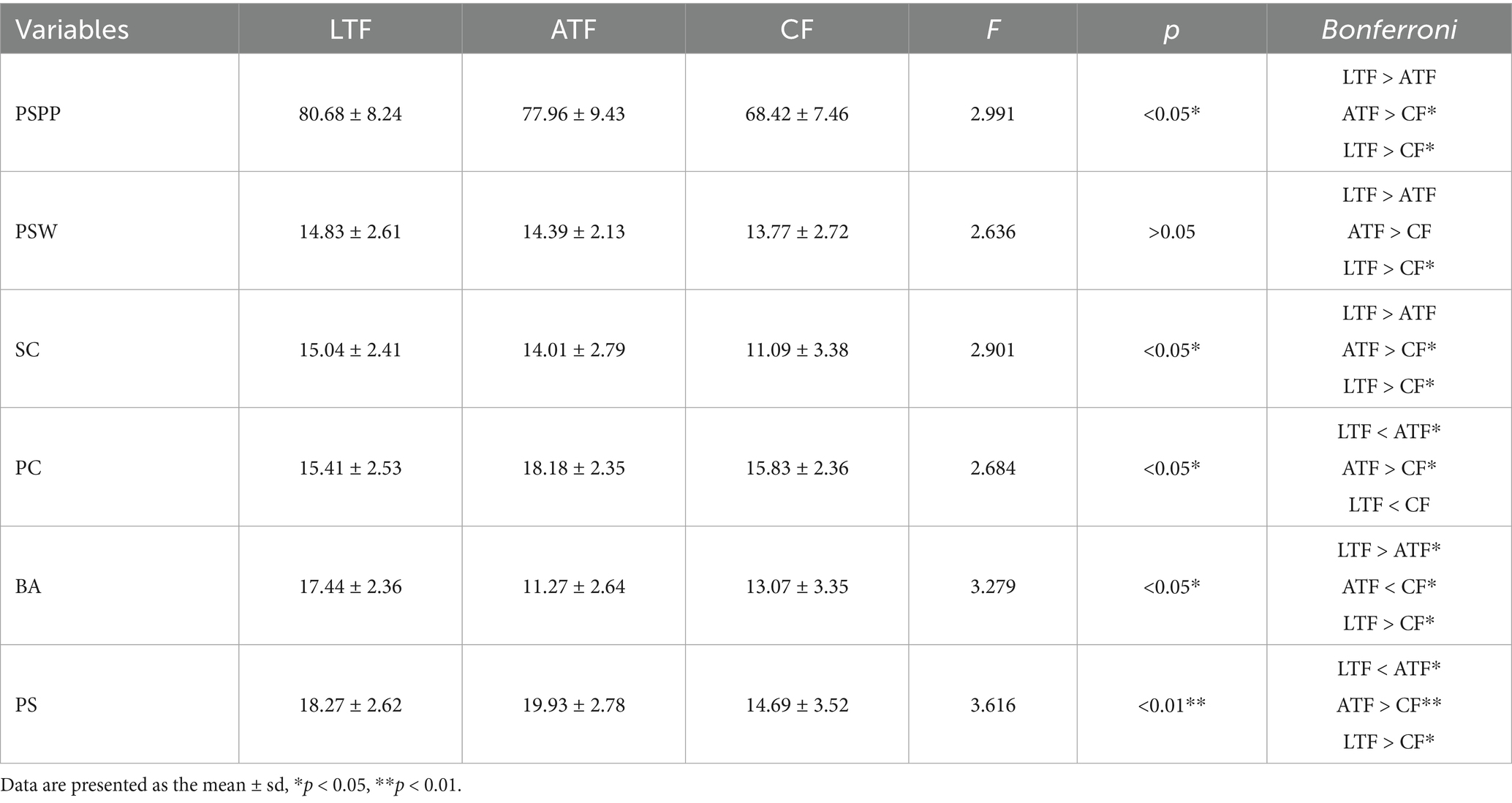
Table 7. Comparative analysis of the differences in body self-esteem among females in each group after the experiment (M ± SD).
In general, after the experiment, the body self-esteem of LTF and ATF was significantly better than that of CF, but not as obvious as that of boys. In terms of small dimensions, ATF had a large gap with LTF in PC and PS, but LTF had a significant advantage in the evaluation of BA. In terms of PSW and SC, the difference between the two was not large, and it was better than the pre-test level in all dimensions. The changing trend is shown in Figures 8, 9.
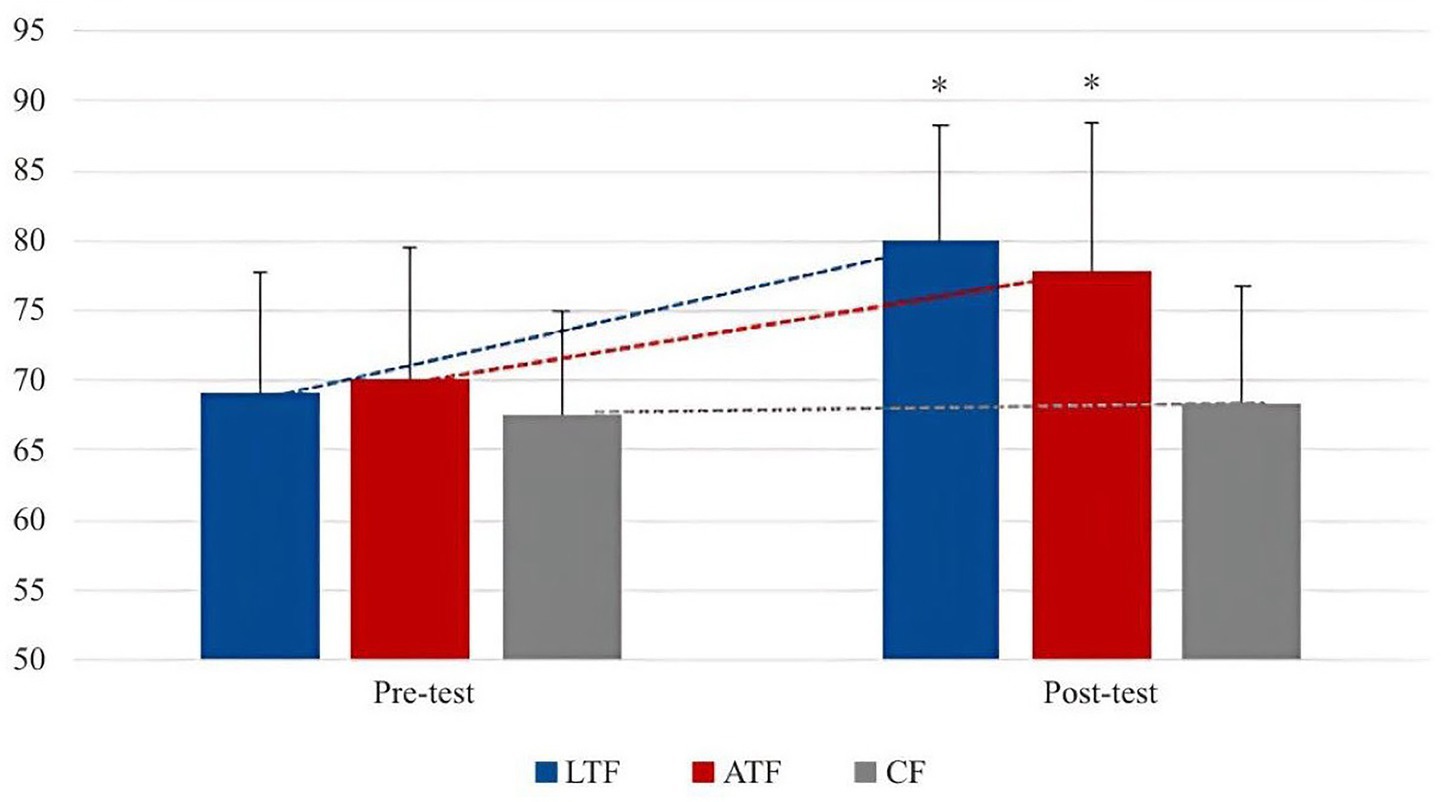
Figure 8. The trend of the total scores of body esteem in each group of females between pre- and post-test.
4 Discussion
The present study aimed to evaluate the effects of Latin dance compared to aerobics on body esteem among college students and to explore potential gender differences in these effects. The results clearly demonstrate significant improvements in body esteem following both exercise interventions, which aligns with existing literature supporting physical activity as a beneficial intervention for body image and self-esteem enhancement (Fernandez-Bustos et al., 2019; Huang et al., 2007; Morales-Sanchez et al., 2021; Rusu et al., 2025; Teixeira et al., 2025). Importantly, the improvements varied between Latin dance and aerobics across several dimensions of body esteem, suggesting distinct underlying mechanisms and implications for practice.
4.1 Overall effects of Latin dance and aerobics
Our findings indicate substantial improvements in overall body esteem for participants engaged in Latin dance and aerobics compared to the control group. Both forms of exercise significantly elevated students’ general physical self-worth, sports competence, physical condition, body attractiveness, and physical strength, reinforcing previous findings that structured physical activities positively impact psychological health and body perceptions (Edwards et al., 2005; Fox, 2003; Gualdi-Russo et al., 2022). The pronounced improvement observed underscores the integral role of regular physical activity in fostering a positive self-image and enhancing mental well-being among college students, a population frequently vulnerable to body dissatisfaction and self-esteem issues (Pastore et al., 2015; Pop, 2016).
4.2 Comparative analysis of Latin dance versus aerobics
Although both the Latin dance and aerobic groups showed improvements, the Latin dance participants showed a more significant improvement in physical attractiveness and athletic ability (corrected p-value < 0.05, Bonferroni method). Aerobic exercise showed significant improvements in physical fitness and strength (corrected p-value < 0.05, Bonferroni method). A plausible explanation is that in Latin dance, rhythmic control and postural attention help them to focus on physical aesthetics and motor skills; these traits may reinforce positive evaluations of appearance and perception (Hu et al., 2024; Li et al., 2023). This outcome resonates with previous research highlighting dance’s unique role in enhancing body image through creative and social engagement (Bicenturk, 2024; Grogan et al., 2014).
Conversely, aerobics training yielded greater gains in physical condition and physical strength dimensions, reflecting its structured, fitness-oriented nature that emphasizes endurance, muscular strength, and cardiovascular health (Schjerve et al., 2008). The goal-oriented and progressively challenging aspects of aerobics may contribute significantly to these particular improvements, aligning with studies suggesting aerobic activities effectively boost physical health perceptions and body functionality (Wilmore, 2003).
4.3 Gender-specific effects
An essential finding from our study is the observed gender differences in response to the exercise interventions. Male participants demonstrated greater improvements in overall body esteem, particularly in physical strength and physical condition dimensions, after aerobics training compared to Latin dance. Compared to Latin dance, aerobic exercises may better align with most men’s focus on fitness and performance due to their functional, progressive, and muscular endurance characteristics (Hands et al., 2016). However, given that the evidence is limited to the subdimensions of PS and PC, this explanation still requires caution and cannot directly conclude that men generally prefer functionality.
Female participants, on the other hand, exhibited pronounced improvements in body attractiveness and sports competence from Latin dance training. Latin dance likely addresses the societal pressures women frequently encounter regarding appearance, offering a holistic approach that incorporates emotional (Quiroga Murcia et al., 2010) and social elements (Green, 2001) along with physical fitness. These findings corroborate previous research that suggests expressive physical activities like dance have significant psychosocial benefits for women, promoting acceptance, self-expression, and enhanced body image (Crosby, 2013; Fourie and Lessing, 2010; Pandya, 2024).
4.4 Mechanisms and practical implications
The observed differential benefits can be attributed to inherent characteristics of each exercise modality. Latin dance, with its emphasis on rhythm, coordination, and social interaction, fosters emotional connection, community belonging, and expressive freedom (Liu et al., 2023), which might indirectly elevate body esteem by reducing psychological stress and promoting positive social interactions (Li, 2023).
Aerobics, with its structured progression and tangible fitness outcomes, enhances self-efficacy, physical health perceptions, and accomplishment. The clear progression and achievement of fitness goals in aerobics provide measurable feedback that directly boosts physical self-worth and strength perceptions, particularly resonating with those valuing clear fitness outcomes (Kim et al., 2025).
From a practical standpoint, educators and fitness professionals should consider integrating both Latin dance and aerobics into physical education curricula and campus wellness programs to cater to diverse student needs and preferences. Specifically, Latin dance could be recommended for individuals seeking psychosocial benefits and improved body attractiveness, while aerobics may be more suited for those prioritizing fitness goals and physical strength.
4.5 Limitations and future directions
Despite its contributions, this study has certain limitations. The relatively small sample size and short intervention period might have constrained the comprehensiveness of the outcomes. Additionally, cultural perceptions influencing the gendered response to exercise modalities were not explicitly measured and could be explored further. Future research should consider longitudinal designs to evaluate sustained effects, larger diverse populations for greater generalizability, and qualitative analyses to understand deeper psychosocial impacts.
5 Conclusion
In conclusion, this study demonstrates significant benefits of both Latin dance and aerobics on body esteem in college students, highlighting distinct gender-specific responses to these exercise modalities. Latin dance uniquely enhances attractiveness and athletic ability, particularly benefiting female participants, whereas aerobics effectively boosts physical strength and conditioning, appealing especially to male participants. These findings underscore the importance of providing varied exercise options within college wellness programs to holistically support students’ psychological and physical health.
Data availability statement
The raw data supporting the conclusions of this article will be made available by the authors, without undue reservation.
Ethics statement
The study protocol was approved by the Research Ethics Review Committee of Hunan Normal University Ethics Committee (Approval ID: 2024646) and was conducted in accordance with the Declaration of Helsinki. The studies were conducted in accordance with the local legislation and institutional requirements. The participants provided their written informed consent to participate in this study.
Author contributions
YH: Conceptualization, Methodology, Writing – original draft, Writing – review & editing. YZ: Resources, Writing – review & editing, Writing – original draft, Formal analysis. HD: Investigation, Writing – review & editing, Writing – original draft, Methodology. HL: Writing – original draft, Writing – review & editing, Data curation.
Funding
The author(s) declare that financial support was received for the research and/or publication of this article. This research is a research result of Anhui Province’s Philosophy and Social Science Planning Project, with project approval number: AHSKQ2024D089, and has been funded by the Guangdong Province Speed Capacity Research Key Laboratory Open Fund Project (2023B1212010009).
Conflict of interest
The authors declare that the research was conducted in the absence of any commercial or financial relationships that could be construed as a potential conflict of interest.
Generative AI statement
The authors declare that no Gen AI was used in the creation of this manuscript.
Any alternative text (alt text) provided alongside figures in this article has been generated by Frontiers with the support of artificial intelligence and reasonable efforts have been made to ensure accuracy, including review by the authors wherever possible. If you identify any issues, please contact us.
Publisher’s note
All claims expressed in this article are solely those of the authors and do not necessarily represent those of their affiliated organizations, or those of the publisher, the editors and the reviewers. Any product that may be evaluated in this article, or claim that may be made by its manufacturer, is not guaranteed or endorsed by the publisher.
References
Aishwarya, S., and Kumar, P. (2024). Aerobic exercise versus plyometrics in reducing anxiety levels in college students with mild generalized anxiety disorder. Cureus 16. doi: 10.7759/cureus.70165
Bahri, S. (2024). A study on body image and self-esteem among young women. Int. J. Interdiscip. Approaches Psychol. 2:1.
Bicenturk, F. (2024) Investigating benefits of creative dance of cognitive, social and creative development with children aged 6–7 years Canterbury Christ Church University
Biderman, C., Bianchini, G., and Bodell, L. P. (2025). The role of negative evaluation fears on associations between societal appearance pressures and disordered eating in university students. J. Am. Coll. Heal. 73, 168–176. doi: 10.1080/07448481.2023.2208240
Chair, S. Y., Chan, A. W. K., Choi, K. C., Liu, T., So, W. K. W., Gao, R., et al. (2024). Evaluation of the psychometric properties of the translated physical self-perception profile among Chinese breast Cancer survivor. Asian Nurs. Res. (Korean Soc Nurs Sci) 18, 401–407. doi: 10.1016/j.anr.2024.09.011
Chekhovskaya, А. (2023). The impact of aerobics on the physical condition of students. Науковий часопис Українського державного університету імені Михайла Драгоманова. Серія. 3, 12–15.
Cook, G., Burton, L., Hoogenboom, B. J., and Voight, M. (2014). Functional movement screening: the use of fundamental movements as an assessment of function - part 1. Int. J. Sports Phys. Ther. 9, 396–409.
Crosby, S. M. (2013). Preliminary evaluation of a girls' empowerment program: The effects of dance on self-esteem and body-image. Malibu, California: Pepperdine University.
dos Bucco Santos, L., del Álvarez Palacio, E., and Zubiaur González, M. Percepção do autoconceito físico de escolares de onze a dezesseis anos fisicamente ativos. Lect. Educ. Fis. Dep. 22, 16–25. Available online at: https://test.efdeportes.com/index.php/EFDeportes/article/view/38
Edwards, S. D., Ngcobo, H. S., Edwards, D. J., and Palavar, K. (2005). Exploring the relationship between physical activity, psychological well-being and physical self-perception in different exercise groups. South African J. Res. Sport Physical Educ. Recreation 27, 59–74.
Ege, G., and Omuris, E. (2024). Latin dance: a socio-cultural exploration of body and dance. J. Interdiscip. Art Educ. 5, 175–183.
Fernandez-Bustos, J. G., Infantes-Paniagua, A., Cuevas, R., and Contreras, O. R. (2019). Effect of physical activity on self-concept: theoretical model on the mediation of body image and physical self-concept in adolescents. Front. Psychol. 10:1537. doi: 10.3389/fpsyg.2019.01537
Fourie, J., and Lessing, A. C. (2010). The influence of dance and movement therapy (DMT) on the body image of female adolescents: dance. African J. Physical Health Educ. Recreation Dance 16, 297–315. doi: 10.4314/ajpherd.v16i2.55968
Fox, K. R. (1990). The physical self-perception profile manual : North Illinois University Office of Health Promotion.
Fox, K. R. (2003). “The effects of exercise on self-perceptions and self-esteem” in Physical activity and psychological well-being (Routledge), 100–119.
Green, J. (2001). Socially constructed bodies in American dance classrooms. Res. Dance Educ. 2, 155–173. doi: 10.1080/14647890120100782
Grogan, S., Williams, A., Kilgariff, S., Bunce, J., Heyland, J. S., Padilla, T., et al. (2014). Dance and body image: young people’s experiences of a dance movement psychotherapy session. Qual. Res. Sport, Exerc. Health 6, 261–277. doi: 10.1080/2159676X.2013.796492
Gualdi-Russo, E., Rinaldo, N., and Zaccagni, L. (2022). Physical activity and body image perception in adolescents: a systematic review. Int. J. Environ. Res. Public Health 19:13190. doi: 10.3390/ijerph192013190
Hagger, M. S., and Stevenson, A. (2010). Social physique anxiety and physical self-esteem: gender and age effects. Psychol. Health 25, 89–110. doi: 10.1080/08870440903160990
Hale, G. E., Colquhoun, L., Lancastle, D., Lewis, N., and Tyson, P. J. (2021). Review: physical activity interventions for the mental health and well-being of adolescents - a systematic review. Child Adolesc. Ment. Health 26, 357–368. doi: 10.1111/camh.12485
Hands, B., Larkin, D., Cantell, M. H., and Rose, E. (2016). Male and female differences in health benefits derived from physical activity: implications for exercise prescription. J. Womens Health Issues Care 5.
Henry, R. N., Anshel, M. H., and Michael, T. (2006). Effects of aerobic and circuit training on fitness and body image among women. J. Sport Behav. 29:281.
Herbert, C. (2022). Enhancing mental health, well-being and active lifestyles of university students by means of physical activity and exercise research programs. Front. Public Health 10:849093. doi: 10.3389/fpubh.2022.849093
Hu, F., Qiu, X., Wu, X., Wu, X., Li, H., and Kim, S. (2024). Effects of dance sports exercise on vestibular function and balance of children with sensorineural hearing loss; a randomized quasi-experimental trial. Front. Pediatr. 12:1426343. doi: 10.3389/fped.2024.1426343
Huang, J. S., Norman, G. J., Zabinski, M. F., Calfas, K., and Patrick, K. (2007). Body image and self-esteem among adolescents undergoing an intervention targeting dietary and physical activity behaviors. J. Adolesc. Health 40, 245–251. doi: 10.1016/j.jadohealth.2006.09.026
Ingram, M. (2013) Unfolding self-esteem adolescent girls' self-esteem and the dance/movement therapy intervention of improvisation and planned movement formation: a pilot study. Creative Arts Therapies Theses. 47. Available online at: https://digitalcommons.colum.edu/theses_dmt/47
Jati, I. C., Hermawan, H. A., Komari, A., Hastuti, T. A., Mohammad, R., and Arianto, A. C. (2024). Differences in body mass index, physical selfconcept, and selfconfidence in adolescent boys and girls, vol. 24: Fizjoterapia Polska(4), 252–259.
Kim, M., Oja, B. D., and Anagnostopoulos, C. (2025). Positive sport organizational insights : Taylor & Francis.
Kling, K. C., Hyde, J. S., Showers, C. J., and Buswell, B. N. (1999). Gender differences in self-esteem: a meta-analysis. Psychol. Bull. 125, 470–500. doi: 10.1037/0033-2909.125.4.470
Koch, S., Kunz, T., Lykou, S., and Cruz, R. (2014). Effects of dance movement therapy and dance on health-related psychological outcomes: a meta-analysis. Arts Psychother. 41, 46–64. doi: 10.1016/j.aip.2013.10.004
Kuang, Y. (2024). The impact of aerobics on body image perception of college students. J. Educ. Educational Res. 8, 372–375. doi: 10.54097/dpew0a44
Li, Q. (2023). The promoting effect of sports dance art learning on college students' mental health. Revista de Psicología del Deporte (Journal of Sport Psychology) 32, 428–436.
Li, H., Kim, Y., Zhou, Z., Qiu, X., and Kim, S. (2023). Effects of cha-cha dance training on physical-fitness-related indicators of hearing-impaired students: a randomized controlled trial. Bioengineering (Basel) 10:1106. doi: 10.3390/bioengineering10091106
Li, H., Qiu, X., Yang, Z., Zhang, Z., Wang, G., Kim, Y., et al. (2022). Effects of cha-cha dance training on the balance ability of the healthy elderly. Int. J. Environ. Res. Public Health 19:13535. doi: 10.3390/ijerph192013535
Liu, C., Jia, S., Wang, X., Wang, X., and Wang, X. (2024). The impact of single sessions of aerobic exercise at varying intensities on depressive symptoms in college students: evidence from resting-state EEG in the parietal region. BMC Psychiatry 24:928. doi: 10.1186/s12888-024-06322-w
Liu, X., Soh, K. G., and Omar Dev, R. D. (2023). Effect of Latin dance on physical and mental health: a systematic review. BMC Public Health 23:1332. doi: 10.1186/s12889-023-16221-6
Liu, Y., and Zhao, X. (2022) The effect of aerobics exercise on professional women’s mental health and body composition.
Merino, M., Tornero-Aguilera, J. F., Rubio-Zarapuz, A., Villanueva-Tobaldo, C. V., Martín-Rodríguez, A., and Clemente-Suárez, V. J. (2024). Body perceptions and psychological well-being: a review of the impact of social media and physical measurements on self-esteem and mental health with a focus on body image satisfaction and its relationship with cultural and gender factors. Healthcare 12:1396. doi: 10.3390/healthcare12141396
Monteiro, L. A. C., Fernandes, H. M. G., Santos, M., and Novaes, J. (2018). The influence of dance practice on the body image of adolescents: a systematic review. J. Exerc. Physiol. 21, 158–169.
Morales-Sanchez, L., Luque-Ribelles, V., Gil-Olarte, P., Ruiz-Gonzalez, P., and Guil, R. (2021). Enhancing self-esteem and body image of breast Cancer women through interventions: a systematic review. Int. J. Environ. Res. Public Health 18:1640. doi: 10.3390/ijerph18041640
Moratelli, J. A., Veras, G., Lyra, V. B., Silveira, J. D., Colombo, R., and de Azevedo Guimaraes, A. C. (2023). Evidence of the effects of dance interventions on adults mental health: a systematic review. J. Dance Med. Sci. 27, 183–193. doi: 10.1177/1089313X231178095
Nicolosi, S., Ortega Ruiz, R., Sgro, F., Lipoma, M., and Benitez Sillero, J. D. (2024). Psychometric validation of the revised physical self-perception profile: an Italian context study. Behav. Sci. (Basel) 14:1229. doi: 10.3390/bs14121229
Ómarsson, B. P. (2013). Effects of sport participation on adolescent self-esteem and body-image: Differences in gender and types of sports explored.
Pandya, S. P. (2024). Women with disabilities, body image, and wellbeing: assessing the effectiveness of dance sessions. J. Bodyw. Mov. Ther. 39, 142–155. doi: 10.1016/j.jbmt.2024.02.019
Pastore, V., Colombo, K., Maestroni, D., Galbiati, S., Villa, F., Recla, M., et al. (2015). Psychological problems, self-esteem and body dissatisfaction in a sample of adolescents with brain lesions: a comparison with a control group. Brain Inj. 29, 937–945. doi: 10.3109/02699052.2015.1008045
Pop, C. (2016). Self-esteem and body image perception in a sample of university students. Eurasian J. Educ. Res. 16, 31–44. doi: 10.14689/ejer.2016.64.2
Pop, C. L., and Ciomag, R. V. (2024). Mediating role of self-esteem on university students’ physical activity attitude and frequency. Physic. Educ. Students 28, 279–285. doi: 10.15561/20755279.2024.0504
Quiroga Murcia, C., Kreutz, G., Clift, S., and Bongard, S. (2010). Shall we dance? An exploration of the perceived benefits of dancing on well-being. Arts Health 2, 149–163. doi: 10.1080/17533010903488582
Riaz, J., Sharif, N., Manzoor, S., Asim, M., Ahmad, S., and Ma, K. (2024). Effect of aerobic strength training on physical fitness and weight loss of female university students. Bull. Bus. Eco. (BBE). 13. doi: 10.51846/the-sky.v8i2.3881
Rusu, L., Piele, D., Ilie, E., Ionescu, G., Marin, M. I., Rusu, M. R., et al. (2025). The relationship between body composition, physical activity, self-esteem, and body image in female and male adolescents. Sports (Basel) 13:11. doi: 10.3390/sports13010011
Salo, A. (2019). The power of dance: How dance effects mental and emotional health and self-confidence in young adults.
Sanchez, D. (2020). Dignity and respect in the salsa dance classroom: Fostering healthy self-esteem to promote compassion.
Schjerve, I. E., Tyldum, G. A., Tjonna, A. E., Stolen, T., Loennechen, J. P., Hansen, H. E., et al. (2008). Both aerobic endurance and strength training programmes improve cardiovascular health in obese adults. Clin. Sci. (Lond.) 115, 283–293. doi: 10.1042/CS20070332
Shapiro, S. B. (2008). Dance in a world of change: Reflections on globalization and cultural difference : Human Kinetics.
Shu, J., Lu, T., Tao, B., Chen, H., Sui, H., Wang, L., et al. (2023). Effects of aerobic exercise on body self-esteem among Chinese college students: a meta-analysis. PLoS One 18:e0291045. doi: 10.1371/journal.pone.0291045
Singh, B., Olds, T., Curtis, R., Dumuid, D., Virgara, R., Watson, A., et al. (2023). Effectiveness of physical activity interventions for improving depression, anxiety and distress: an overview of systematic reviews. Br. J. Sports Med. 57, 1203–1209. doi: 10.1136/bjsports-2022-106195
Teixeira, M. S., Christofaro, D. G., Delfino, L. D., Saraiva, B. T., Santos, A. B., Leite, E. G., et al. (2025). Relationship of self-esteem with different domains and intensities of habitual physical activity in community-dwelling adults. Transl. J. Am. Coll. Sports Med. 10:e000302. doi: 10.1249/TJX.0000000000000302
Wang, Y., Kim, K., and Shao, Q. (2025). Dance sport involvement and behavioural loyalty: body image and self-efficacy among university students. J. Psychol. Afr. 34, 514–523. doi: 10.1080/14330237.2024.2425229
Keywords: body esteem, body image, physical self-perception profile (PSPP), Latin dance, aerobics, college students, gender differences, randomized controlled trial
Citation: Hu Y, Zeng Y, Dong H and Li H (2025) The influence of exercise on body esteem among college students of different genders: evidence from Latin dance and aerobics. Front. Psychol. 16:1648594. doi: 10.3389/fpsyg.2025.1648594
Edited by:
Qing Yi, Dalian University, ChinaReviewed by:
Xutao Liu, Jiangsu University of Science and Technology, ChinaHonglin Qu, Yichun University, China
Youngsuk Kim, Jeonbuk National University, Republic of Korea
Copyright © 2025 Hu, Zeng, Dong and Li. This is an open-access article distributed under the terms of the Creative Commons Attribution License (CC BY). The use, distribution or reproduction in other forums is permitted, provided the original author(s) and the copyright owner(s) are credited and that the original publication in this journal is cited, in accordance with accepted academic practice. No use, distribution or reproduction is permitted which does not comply with these terms.
*Correspondence: Han Li, bGloYW5AYWhudS5lZHUuY24=; Heling Dong, aGVsaW5nZG9uZ0BqbnUuZWR1LmNu
 Yuna Hu1,2
Yuna Hu1,2 Han Li
Han Li
